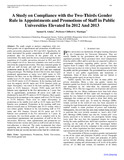| dc.description.abstract | The study sought to analyze compliance with two-thirds gender rule in appointments and promotions of staff in new public universities chartered in 2012 and 2013. Specifically, the study determined the gender composition of staff appointed or promoted after the provision of the gender rule in the constitution. The study used the survey research design that had a population of 15 public universities elevated in 2012 and 2013 and a sample size of six. Interview schedules were used to collect data from the sampled universities. This data contained gender of staff per staff division and staff level in appointments and promotions made in 2011, 2012 and 2013 and were analyzed using percentages. The findings showed that in total, men largely dominated appointments at senior level (66% males to 34% females) but there was no big difference in appointments at the middle level (51.2% males to 48.8% females) and support staff level (56.6% males to 43.4% females). In the teaching staff, men were the majority (64.6% males and 35.4% females) while no major discrepancy was noted in the non teaching staff (56.8% males to 43.2% females). Overall, 59.8% males and 40.2% females were appointed in the five universities in 3 years. Just like in appointments, promotions of senior level staff were dominated by men (69.5% males to 30.5% females). Men equally featured in the promotions at the support staff level (76.5% males to 23.5% females). There were no major discrepancy in promotions at the middle level staff as 44.2% males and 55.8% females were promoted. Promotions in the teaching staff were skewed towards men at 70.9%males and 29.1% women while it was almost gender balanced in the non-teaching staff at 51% males and 49% females. Overall, 65.3% males and 34.7% females were promoted in the five universities in 3 years. In conclusion, the two-thirds gender rule is complied with in the consolidated appointments and promotions of staff in the five universities. However, when appointments and promotions are broken down into various units such as staff levels and divisions, non-adherence is observed. The study recommends that when appointing and promoting staff, the gender rule consideration should be done per section and units rather than for a whole unit. | en_US |

